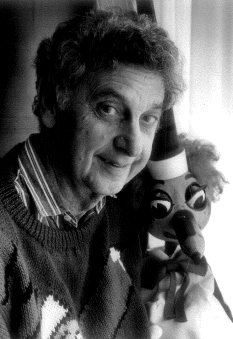Mr. Squiggle
Norman Hetherington was born on 29 May 1921 in Lilyfield, Sydney. After finishing school, he served during the Second World War (1941–1945) as a lightning-sketch artist with an Army
| Norman Hetherington | ||
 | ||
| Hetherington with ''Mr Squiggle'' | ||
| Born | Born May 29, 1921 Lilyfield, Sydney, New South Wales, Australia | |
| Nationality | Australian | |
| Occupation(s) | Cartoonist, puppeteer, television performer | |
| Years active | 1940s–2000s | |
| Known for | Creator and performer of ''Mr Squiggle'' | |
| Spouse(s) | Margaret Purnell (m. 1958) | |
| Children | 2 (Stephen, Rebecca) | |
| Notable works | ''Mr Squiggle'', ''Smiley’s Good Teeth Puppet Theatre'', ''Puppets of Australia'' | |
| awards | Order of Australia Medal (1990); UNIMA Member of Honour (2008) | |
Entertainment Unit, performing for troops in Australia, New Guinea and nearby islands.
From 1946 to 1961 he worked as a full-time cartoonist for The Bulletin, signing his work “Heth”. Around 1949 he began experimenting with puppets, inspired by instructions in a 1935 issue of Popular Science Monthly. He soon became involved in Sydney’s lively post-war puppetry scene, learning from companies such as the Clovelly Puppet Theatre and performing with his own marionettes.
By 1953 Hetherington was staging productions such as The Reluctant Dragon at the Mercury Theatre, earning positive reviews in the Sydney press. On 5 November 1956 his puppets appeared during the very first ABC Channel 2 television broadcast. The following year he worked with ATN Channel 7 on the syndicated Jolly Gene and His Fun Machine.
In 1958 he married Margaret Purnell. The following year saw the birth of their son Stephen, and also the television debut of Mr Squiggle, a puppet character who began as a simple filler but would become a beloved national institution. Their daughter Rebecca was born in 1962 and would later serve as the show’s last presenter in 1989.
Hetherington’s creativity extended beyond Mr Squiggle. In 1968 he created Smiley’s Good Teeth Puppet Theatre for the Dental Health Foundation, a project that toured Australian schools for nearly two decades. In 1974, with Margaret, he produced Puppets of Australia, a major survey supported by the Australian Council for the Arts. He later designed for the Marionette Theatre of Australia, contributing to productions including The Mysterious Potamus (1978), The Wind in the Willows (1986) and Pinocchio (1987).
Alongside television commitments, Norman continued presenting live holiday shows in department stores until 1985. He and Margaret also published Hand Shadows in 1988. The following years brought many honours: in 1990 he was awarded the Order of Australia Medal, in 1999 Mr Squiggle was celebrated on a postage stamp, and in 2003 Nick Stathopoulos’s Archibald Prize finalist portrait of Norman and Mr Squiggle was exhibited at the Art Gallery of New South Wales.
Retrospectives of his work followed, including a major Mosman Art Gallery exhibition in 2005. In 2008 Hetherington was made a Member of Honour of UNIMA at the World Congress in Perth, recognising his lifetime contribution to puppetry. [1]
